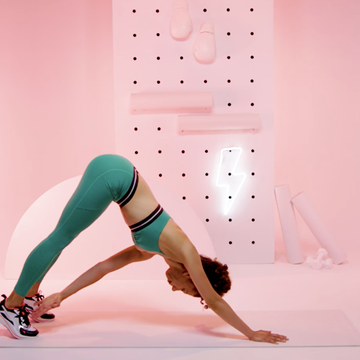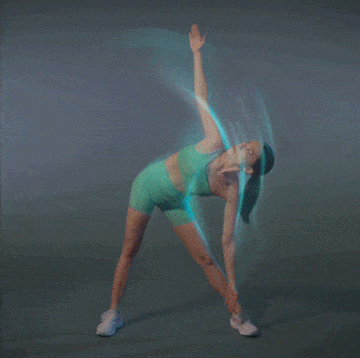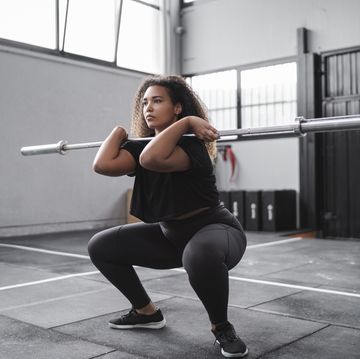Here’s something you don’t hear every day but should: Your pelvis is your bod's true MVP. That bowl-shaped configuration of bones in your lower abdomen is the main support for your spine, assists in transferring weight to your lower limbs, and protects your internal organs. Those are just a few ways your pelvis helps you function, so it’s important not to neglect it. Cue pelvic tilts!
In Pilates, pelvic tilts are a common and fundamental movement involving the positioning of the pelvis in relation to the spine, says Diarra Cummings, a certified Pilates instructor and founder of Snatched Fitness NYC. “Pelvic tilt exercises often involve a rocking or swinging action of the pelvis while stabilizing the legs and spine,” she explains.
Meet the experts: Diarra Cummings is a certified Pilates instructor, with additional certifications in pre/post-natal Pilates, and the founder of Snatched Fitness NYC. Jackie Sherwood is a certified Pilates instructor, former dancer with the Joffrey Ballet, ACE personal trainer, and coach at AKT.
Because the pelvis can tilt forward (anteriorly), backwards (posteriorly), and sideways (laterally), pelvic tilts can help you achieve better posture, strengthen pelvic floor muscles, increase mobility, and alleviate stress or pain on the hips and lower back, she says.
Pelvic tilts also engage the lower abdominal muscles (hello, core!). “The pelvic tilt is important because it brings awareness and ultimately control, strength, and endurance to the intrinsic core stabilizers,” says Jackie Sherwood, a certified Pilates instructor and trainer at AKT. “Having command of the deep internal cylinder of muscles is valuable in maintaining lower back and hip health and assists in overall physical performance.”
Plus, pelvic tilts can boost sexual health. “Tightening and loosening the pelvic floor muscles can help with better sexual functioning,” says Cummings. Studies show that learning to control and strengthen your pelvic floor increases arousal, performance, and pleasure.
How To Do Pelvic Tilts With Proper Form
It’s important to know that pelvic tilts are a subtle, barely visible movement that teach control. “This is not an exercise that you’re going to lose weight or be sore from, but it will help you sustain healthy joints and good mobility,” says Cummings. Try incorporating the move first thing in the morning to help loosen your lower back, or as a warmup or cooldown during your workout routine.
Instructions: Complete two sets of 10 reps, 3-5 days a week.
How to:
- Lie on your back with knees bent, legs hip-width apart, and soles of your feet flat on the floor.
- Keep your arms relaxed by your side and a natural curve in the lower spine (there should be a slight space between your lower back and the floor).
- Inhale, and on the exhale, gently shift your weight into the back-center of your pelvis so your tailbone curves upward, feeling your lower abs engage and sink inward as the lower back flattens. (The gap between the lower back and floor gently closes.)
- Keep your lower back on the mat and hold for 5 seconds.
- Inhale and fully release the tilt, allowing your pelvis to return to starting position. Do 10 reps.
Pro tip: Cummings recommends placing a small ball or yoga block between the inner thighs to stabilize the lower body and maintain correct alignment.
Common Pelvic Tilt Mistakes To Avoid
- Gripping the hip flexors. Instead of tensing your hip flexors and initiating the pelvic tilt with the quads, push down into the feet to engage the hamstrings and inner thighs, says Cummings. After shifting into the tilt, don’t clench or tighten your hip flexors. Instead think of softening or releasing tension, adds Sherwood.
- Smooshing the lower back into the floor. “Pelvic tilts are never about creating compression in the spine,” says Sherwood. Instead, visualize creating space between each vertebrate and gently breathe to encourage a sense of expansiveness as you move the bones of the pelvis, she explains.
- Upper body tension. Pelvic tilts are all about smooth control, so if you hold tension in your neck and/or shoulders, and jut your chin to the ceiling, you are minimizing the benefits. This is particularly common if you are dealing with a lot of lower back tightness. Think about melting the ribcage and back of the head onto the mat, per Sherwood. You can also focus on maintaining a wide feeling across the chest and keeping the shoulder blades anchored to the ground, adds Cummings.
- Glutes overpower the abs. Pelvic tilts are not hip bridges or a glute-focused exercise, says Sherwood. If you find yourself clenching your glutes during the pelvic tilt, think about only moving “the bones,” she says. “Shift the back-center of the pelvis toward the mat, and the targeted muscles will organically correct.”
- Pushing the abs outward. Yes, you should feel your core engage, but you should not push your abs or belly forward, says Cummings. “Pull the waist inward and hollow the abdominal wall before moving the pelvis into the tilt,” she says.
Pro tip: You might already be doing pelvic tilts (especially if you do yoga or Pilates). A lot of core work such as bicycle crunches, forearm planks, and bear planks, require a slight pelvic tilt, says Sherwood.
Pelvic Tilt Benefits
Here's a quick reminder of all the perks that come along with performing pelvic tilts properly:
- Boost sexual health
- Improve mobility and joints
- Engage lower abdominals and core
- Less back discomfort
Pelvic Tilt Variations For All Levels
1. Modify your upper body support.
- Instead of lying flat on your back, prop yourself up onto your forearms. (This gives you a clear view of the pelvis and tilt).
- Move the pelvis forward and back as you normally would with the same step-by-step instructions as above.
- Watch the pelvic movement to help practice control and gain awareness in the subtle motion. Do 10 reps.
2. Sit on a stability ball for more challenge.
- Sit tall on a yoga ball, with feet flat on the floor and hip-width apart.
- Tilt the pelvis so the pubic bone rolls upward and the tailbone rolls forward.
- The ball will slightly shift underneath you, but this positioning will increase difficulty and work on stabilizing your core. Do 10 reps.
3. Level up with a half kneeling position.
- Come to a half kneeling position, with your left foot forward, knee over your foot, and foot flat on the floor.
- Keep your right knee on the ground with your hip directly over your knee.
- Maintain a tall spine with level hip line, hands on hips, and shoulders relaxed.
- Inhale, and on the exhale, think of lifting your pubic bone toward the navel while lengthening the tailbone to the floor.
- Hold positioning for 5 seconds while maintaining a natural breath.
- Exhale and release to the starting position. Do 5 reps on each side.
Who can do pelvic tilts?
The beauty of this simple move is pretty much everyone can enjoy the perks. Pelvic tilts really shine during and after pregnancy.
Pelvic tilts can be a great prenatal exercise as the weight of a baby loads the spine and commonly causes lower back tightness, per Sherwood and Cummings. If lying on your back is uncomfortable during pregnancy, try sitting on a stability ball or come onto all fours (quadruped).
For postnatal recovery, pelvic tilts are a great way to regain connection to the deep intrinsic pelvic stabilizers and condition the transverse abdominis (the deepest layer of abdominal muscles). “Pelvic tilts are also a calming exercise and can be helpful in regaining a sense of center amid the flurry of motherhood, '' says Sherwood.
There are a few folks who should steer clear, though. “Anyone with a recent chronic lower-back injury, severe osteoporosis, recent surgery, or a diagnosis of a posterior spinal herniation should avoid the pelvic tilt until consulting with their doctor,” says Sherwood. If you experience pain while performing the move, check-in with your physician or physical therapist.
Andi Breitowich is a Chicago-based writer and graduate student at Northwestern Medill. She’s a mass consumer of social media and cares about women’s rights, holistic wellness, and non-stigmatizing reproductive care. As a former collegiate pole vaulter, she has a love for all things fitness and is currently obsessed with Peloton Tread workouts and hot yoga.















